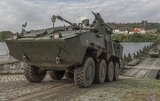Cambridge Consultants unveils counter-terror search technology
Cambridge Consultants, a leading technology design and development firm, today unveiled ‘Sprint', a prototype handheld device which provides a 3D image of objects embedded within walls or floors. Based on Cambridge Consultants' proven short-range radar expertise, Sprint enables an operator to rapidly form an image of subsurface structures such as pipes and cables, as well as detecting items of interest such as concealed explosives and contraband, revolutionising counter-terrorism and crime prevention search techniques.
Law enforcement and security agencies are constantly facing new challenges as criminals and terrorists look for ever more creative ways to conceal weapons or to smuggle contraband, and the Sprint system has been designed to tackle some of the most challenging threat detection scenarios. The London 2012 Olympics, for example, will be one of the toughest security challenges seen in the UK to date and security services will want to leave no stone unturned in the hunt for potential threats. Sprint can quickly and easily look inside anything from the floor to the roof, and the handheld system can simply be moved across a surface to build a larger picture. With many new buildings and facilities being developed for the 2012 games, this technology could provide a unique and innovative way of ensuring that they are clear of any threat.
Unlike existing transmission x-ray systems, the radar-based Sprint system does not require access to both sides of the object in order to scan inside, and provides an easily interpreted image of the wall structure, something which compact radar systems have previously not provided. This significantly improves its application potential and can enable much quicker deployment in scenarios where speed can be critical.
"Whereas other options, such as backscatter x-rays, are cumbersome, expensive and power hungry systems, and conventional radar systems have been difficult to interpret, Sprint's use of radar and processing technology makes it possible to look inside an opaque object or surface from one side safely, cheaply and quickly in a low power, handheld device," commented Sam Pumphrey, Senior Consultant at Cambridge Consultants.
The prototype Sprint device is the equivalent size of a standard sheet of letter paper and 15cm deep, weighing approximately 3.5kg with batteries. It is a multi-channel system, enabling full synthetic aperture processing, and it uses short pulses of energy with high bandwidth to enable the short range, high resolution imaging required. Other potential applications for the technology include industrial inspection, technical search, counter surveillance and a range of military applications.
Cambridge Consultants is currently conducting extensive performance testing to take Sprint beyond the prototype stage and ready it for future commercialization.
Sprint has been developed to sit alongside Cambridge Consultants' Prism 200 device. Prism 200 is a handheld through-wall radar, designed to be used by police, special forces or the emergency services. It provides quick and covert intelligence on the movement and location of people in a room or building - without the need for invasive sensors.
Source: Cambridge Consultants
More from Digital Battlespace
-
![Chess Dynamics successfully demonstrates Vision4ce AI-driven tracker]()
Chess Dynamics successfully demonstrates Vision4ce AI-driven tracker
The Vision4ce Deep Embedded Feature Tracking (DEFT) technology software is designed to process video and images by blending traditional computer vision with artificial intelligence (AI) algorithms to present actionable information from complex environments.
-
![Wave Relay devices cleared for security use on commercial systems in industry trend]()
Wave Relay devices cleared for security use on commercial systems in industry trend
Persistent Systems has been cleared by National Security Agency (NSA) to transmit sensitive data on commercial networks. The devices are added to the NSA’s Commercial Solutions for Classified (CSfC) component list which also includes other companies’ products providing the same security.
-
![UK teases cyber spending boost in Strategic Defence Review ahead of “imminent” release]()
UK teases cyber spending boost in Strategic Defence Review ahead of “imminent” release
The release of the UK’s Strategic Defence Review (SDR) has been long promised as mid-year. It is possible it could be as early as 2 June although the UK Ministry of Defence (MoD) continues to play its cards close to its chest.
-
![Intelsat emphasises SATCOM resilience for SOF in contested domains (video)]()
Intelsat emphasises SATCOM resilience for SOF in contested domains (video)
Intelsat outlines how its multi-orbit SATCOM architecture is enhancing connectivity and resilience for special operations forces operating in degraded and contested environments.
-
![US Space Force’s next-generation missile warning system moves forward with $500 million in new contracts]()
US Space Force’s next-generation missile warning system moves forward with $500 million in new contracts
Next-Generation Overhead Persistent Infrared (Next-Gen OPIR) satellites are intended to provide early warning of missile launches from any location worldwide and new ground stations will result in expanded coverage of critical missile warning.























